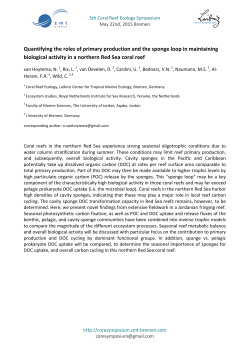
factsheet - Australian Embassy
GREAT BARRIER REEF Australia’s progress in responding to the World Heritage Committee June 2015 The Great Barrier Reef, inscribed on the World Heritage List in 1981, is one of the best managed marine ecosystems in the world. As shown in the table below, Australia has responded comprehensively to all of the requests of the World Heritage Committee and has taken unprecedented action to address the Committee’s concerns about the health and management of the Great Barrier Reef. Australia’s response to the World Heritage Committee Status The need for a long-term plan The ground-breaking Reef 2050 Long-Term Sustainability Plan is a 35 year plan for the management of the Reef based on the strategic environmental assessment of the Reef and the Great Barrier Reef Outlook Report 2014. The Plan focuses on actions to address key threats and directly boost the health and resilience of the Reef so that it is best able to cope with pressures, including the effects of climate change. The Plan will be a schedule of the updated Great Barrier Reef Intergovernmental Agreement. This gives it the highest status available under Australia’s federated system of government. www.environment.gov.au/protection/assessments/strategic/great-barrier-reef www.gbrmpa.gov.au/managing-the-reef/great-barrier-reef-outlook-report www.environment.gov.au/reef2050 In place Managing development in Gladstone Harbour and on Curtis Island The recommendations from the Independent Review of the Port of Gladstone will improve port operation and inform the work of the new Gladstone Healthy Harbour Partnership and other efforts to protect the Great Barrier Reef World Heritage Area. www.environment.gov.au/gladstonereview rc.ghhp.org.au In place Water quality The latest report card shows water quality has improved. Annual sediment loads have been reduced by 11 per cent, pesticides by 28 per cent, and nitrogen by 10 per cent compared with 2009. This is the result of investments by the Australian and Queensland governments of more than $375 million over the past five years, complemented by substantial in-kind investment by industry. Water quality will also be a focus for the new $140 million Reef Trust as well as the Queensland Government’s additional $100 million over five years towards water quality initiatives, scientific research and better environmental practices in the primary production and fishing industries. www.reefplan.qld.gov.au/measuring-success/report-cards/2012-2013-report-card.aspx In place No development to impact individually or cumulatively on the Reef’s Outstanding Universal Value Rigorous environmental assessment under the Environment Protection and Biodiversity Conservation Act 1999 using the new EPBC Act referral guidelines for the Outstanding Universal Value of the Great Barrier Reef World Heritage Area ensures that Outstanding Universal Value is central to the protection of the property. Developments with an unacceptable impact on the Great Barrier Reef will not be approved. In response to commitments made in the strategic environment assessment, Cumulative Impact Assessment Guidelines and a Net Benefit Policy are being prepared to guide decision making. www.environment.gov.au/protection/environment-assessments In place Australia’s response to the World Heritage Committee Status Limiting the impact of ports and port development The Queensland Government will protect greenfield areas by restricting new port development in and adjoining the Great Barrier Reef World Heritage Area to within current port limits. Capital dredging will be restricted to the ports of Gladstone, Hay Point/Mackay, Abbot Point and Townsville. Any new development in these ports must also be consistent with the Great Barrier Reef Marine Park Act 1975, the Queensland Marine Parks Act 2004, their regulations and zoning plans. The Australian Government has permanently banned the disposal of capital dredge material in the Great Barrier Reef Marine Park. Queensland will, through new legislation, prohibit the sea-based disposal of material into the Great Barrier Reef World Heritage Area generated by port related capital dredging and further protect the Fitzroy Delta, including North Curtis Island and Keppel Bay, which are outside the Gladstone Port Area. Significant progress Best practice port planning An action of the Reef 2050 Long-Term Sustainability Plan is to adopt the best practice principles identified in the Gladstone Independent Review reports and integrate them into port planning and development. Master plans will be required at the major ports of Gladstone, Hay Point/Mackay, Abbot Point and Townsville which optimise infrastructure and address operational, economic, environmental and social relationships as well as supply chains and surrounding land uses. In place Rigorous management of shipping The Queensland Government has announced it will not support trans-shipping projects that adversely affect the Great Barrier Reef Marine Park. The North-East Shipping Management Plan released in late 2014, is being implemented to further reduce risks from shipping incidents. It builds on existing arrangements to provide an integrated approach to shipping management in the Great Barrier Reef World Heritage Area, Coral Sea and Torres Strait regions and gives explicit consideration to the Outstanding Universal Value of the World Heritage Area. At Australia’s request, in May 2015 the International Maritime Organization approved the extension of the Great Barrier Reef Particularly Sensitive Sea Area to cover a further 565,000 km² of the South-West Coral Sea. This will help ensure that ships keep away from areas where they could cause significant damage. www.amsa.gov.au/forms-and-publications/Publications/AMSA439.pdf In place Address climate change and other forms of environmental degradation An international solution on climate change is required. Australia is playing its part. Internationally we are working constructively towards a new global climate change agreement that involves all countries and by pledging $200 million to the Green Climate Fund. Domestically we are meeting our 2020 emissions reduction targets and will mitigate climate change through the new $2.55 billion Emissions Reduction Fund, including the legislative safeguards mechanism to ensure emissions reductions secured through the fund are not offset by a significant rise elsewhere in the economy. We are implementing the Great Barrier Reef Climate Change Adaptation Strategy and Action Plan (2012–2017) which outlines how the Great Barrier Reef Marine Park Authority, in collaboration with industry, science and community partners will work to improve the resilience of the Reef so it is better able to cope with stress and reduce the impacts of climate change. elibrary.gbrmpa.gov.au/jspui/handle/11017/114 In place Independent review of institutional and management arrangements for the Reef This review was completed in September 2014. The review identified that legislation for the protection and management of the Reef is generally comprehensive. www.environment.gov.au/marine/gbr/publications/independent-review In place In place Overall protection and management of the property Australia is fully committed to maintaining the Outstanding Universal Value and integrity of the Reef. Strong protection and management foundations are already in place. The integrated delivery of existing and new measures will be given effect through the Reef 2050 Long-Term Sustainability Plan. The Plan and the updated Great Barrier Reef Intergovernmental Agreement will ensure that the Reef’s Outstanding Universal Value is maintained and is central to the protection of the property. In place Request for progress reports on the state of conservation of the Reef Australia has responded to all World Heritage Committee requests since 2011 for progress reports on the state of conservation of the Reef, most recently through the 2015 State Party Report and Addendum, the Great Barrier Reef Outlook Report 2014 and the Reef 2050 Long-Term Sustainability Plan. www.environment.gov.au/world-heritage/gbr In place HER140.0615 Australia will progress streamlined environmental assessments and approvals that maintain existing high environmental standards including consideration of the Outstanding Universal Value and integrity of the property when development proposals are being considered. Queensland has also committed to strengthen legislation to protect native vegetation, including in Great Barrier Reef catchments, effectively manage the coastal zone including wetlands, and ensure that water extraction is managed in accordance with the principles of ecologically sustainable development. www.environment.gov.au/one-stop-shop Images: GBRMPA and Department of the Environment Ensure legislation remains strong and adequate to maintain and enhance Outstanding Universal Value
© Copyright 2025









